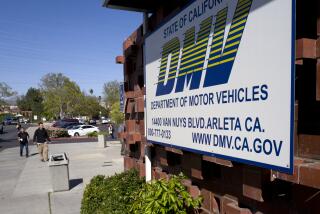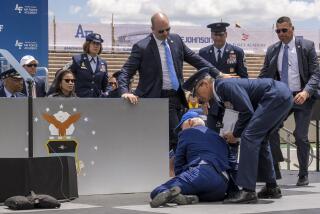Auto Makers Retool to Fit an Aging U.S.
- Share via
WASHINGTON — A little-known study showing that the elderly are dying in traffic accidents at twice the rate of other adults, often in easily survivable crashes, is prompting a reexamination of auto safety devices, from seat belts to test dummies.
Safety experts and auto makers alike are raising concerns that protecting the brittle bones of America’s growing elderly population is the greatest challenge of the next 20 years for the industry.
“We are asking people to sit up and take notice that this is going to be a growing problem,” said Dr. Stewart Wang, a surgeon at the University of Michigan’s Trauma Burn Center in Ann Arbor, whose curiosity prompted the research. “We can chalk it up to frailty and say there is nothing we can do, or we can raise the bar on vehicle design and testing.”
The Michigan facility is one of nine trauma centers that form the Crash Injury Research and Engineering Network, a partnership created in 1996 among the federal government, major hospitals and some auto makers.
Network researchers discovered that rib fractures--painful but not life-threatening for most adults--are killing the elderly. The findings, quietly circulating for months, could prompt action from federal regulators who set vehicle safety standards for the automobile industry.
While making vehicles safer for children has become an urgent priority of regulators and auto makers, network cases show that older people are dying of chest injuries--rib fractures, collapsed lungs, damaged hearts and ruptured arteries--at markedly higher rates than younger adults.
The problem is expected to get worse as Americans live longer and continue to drive in their 80s and 90s. Already, the elderly are the fastest-growing group of licensed drivers and the only age group that has shown an increase in deaths among drivers and passengers in the last decade.
However, despite promising ideas and initiatives from individual auto makers, there is no consensus about how to improve the odds of survival for the elderly.
Critics, including AARP, say that not enough is being done. For example, AARP (formerly the American Assn. of Retired Persons) supports the development of a crash test dummy that could model the effects of aging on the human body. While the “family” of dummies is being expanded to include an infant, a toddler and an elementary-school-age child, grandmother and grandfather are not yet in the picture.
“The primary model that has been used in safety has been a healthy young adult,” said Dr. Jeffrey Augenstein of the William Lehman Injury Research Center in Miami, part of the crash injury network. “But increasingly, older people are behind the wheel.”
Deaths of Older Drivers May Double
The number of licensed drivers age 70 or older is expected to increase more than 60%, to about 31 million, by 2020. In the same period, some analysts project that deaths among drivers 65 and older will double, from an estimated 5,232 this year to an estimated 10,363 in 2020.
Auto crashes already are the most common reason, exceeding even falls, for elderly people to be transported to trauma centers.
Aware of the trend, some auto makers have been designing shoulder belts that are more forgiving to a frail chest. In the future, vehicles may incorporate technology that fine-tunes air bags and belts to match people of any age.
“I can see people getting into their cars and having their own personal key that conveys to the vehicle who they are--their height, weight and age--so the restraint system would be able to preset its characteristics,” said Rolf Eppinger, chief of biomechanics for the National Highway Traffic Safety Administration. “We are at a point where we have to say there is no ‘one size fits all’ for safety.”
Wang became interested in elderly crash victims because they were turning up in growing numbers in his intensive care unit at the University of Michigan hospital. “As a trauma surgeon, I was just seeing so many of these patients coming in--and they were very challenging to take care of.”
Contrary to a widespread perception, government statistics on drivers show that the elderly, on the whole, are safe behind the wheel. They worry about getting socked with traffic tickets and higher insurance bills, so they plan their routes and rarely engage in dangerous behavior such as drinking and driving, experts say. They also avoid night driving and busy highways.
Wang and his colleagues began their investigation by reaching out to other crash research network centers--in Baltimore, Miami, San Diego, Seattle and Newark, N.J. They assembled a file of 300 cases involving belted victims of all ages in late-model vehicles.
New Focus on Chest Trauma
Analyzing the cases, they found that drivers and passengers age 60 and older were more than twice as likely to be killed in accidents as other adults. Even in moderate crashes, the elderly were in greater danger of being seriously injured or killed.
The network researchers also found that serious injuries were occurring in a completely different way than previously believed. Studies from the early 1980s had identified head injuries as the leading cause of crash deaths among the elderly. But the network data showed that 86% of the elderly who were killed had chest trauma, while only 38% had head injuries. (Some victims had both types of injuries.)
Part of the explanation for the change in injuries since the 1980s appears to be that seat belts and air bags are doing a better job of protecting heads. For the elderly, the same cannot be said for the chest.
Surprisingly, nearly 40% of those who died had suffered no more serious injuries than broken ribs.
“A rib fracture in a younger adult hurts like heck, and you can’t breathe as deeply, but it’s not a big deal,” Wang said. However, “the elderly have very little tolerance for setbacks, and things tend to snowball. They don’t have the lung capacity. If they break a couple of ribs, they can wind up on a ventilator, get pneumonia and end up dying.”
Wang double-checked the findings from network cases against a government database that collects a larger and much broader sample of crashes. It mirrored his data. For example, in the larger database, people age 70 through 79 accounted for fewer than 5% of those involved in crashes but 26% of those with eight or more rib fractures.
Examples from network files--with names deleted because of privacy rules--show how age and its complications can lead to more severe injuries.
In a 1998 crash in Miami, a Toyota Camry driven by a 76-year-old man glanced off a Chevrolet Nova that had cut in its path at an intersection. The Camry wound up striking a concrete pole at a “moderate” 15 mph.
But the man’s injuries were serious. He suffered three broken ribs from the impact of the air bag. The pressure of his weight against his shoulder belt bruised his right lung. Unable to breathe on his own, he was placed on a ventilator in the intensive care unit. He spent 10 days in the hospital, and his bill came to nearly $41,000.
In a 1999 crash in Michigan, an 83-year-old man made a left turn at an intersection and crashed his 1997 Ford Escort station wagon head-on into a Chevrolet Cavalier traveling in the opposite direction. The elderly driver only scraped his right hand in the 20 mph collision.
But his female passenger, a 79-year-old retired auto engineer, was badly hurt, even though she was wearing her seat belt. She already suffered from back problems and had been injured in a previous crash. This time, she broke three ribs, a vertebra in her neck, her left kneecap and a leg bone below it. Discharged after more than a week in the hospital, she was soon back with fluid in her lungs.
Her granddaughter took a month off from work to care for her at home, but family members told doctors that they were troubled by the patient’s “failure to thrive.” Two months after the crash, the woman was complaining of memory loss and her injured knee had become infected.
Augenstein, the Miami doctor, said that a crash does not have to be catastrophic to cause an older person’s world to unravel. “With a little bit of trauma in the elderly, you can go from being an active, well-functioning person to being a nonfunctioning person. Once somebody is disabled in their late 70s and 80s, their ability to return to where they were before is very poor.”
Wang and Augenstein believe the crash research network findings may point to a need for the federal traffic safety agency to set stricter standards to prevent chest injuries in collisions.
Wang also is interested in the development of new safety devices that might benefit the elderly. “We could make the seat belt inflatable. There could be a small air bag in the shoulder portion of the belt that expands so the load to the chest is spread over a broader area.”
Car Makers Take the Initiative
Although the industry lacks a comprehensive solution, individual auto makers--without any mandate from the government--have taken several steps to address the problem.
For example, General Motors has used a device called a “force limiter” in its seat belts since the early 1990s. In a head-on collision, the force limiter lets the shoulder belt give a little once the air bag has filled. That provides a broader area to absorb crash forces and prevents the belt from becoming a taut band around a person’s chest.
“We definitely want to try to address the special needs of occupants and improve the restraint capability of our vehicles,” said Mick Scherba, a GM manager who is responsible for making sure that different safety systems work in concert.
The new, lower-power air bags that manufacturers have been installing since 1998 also should benefit the elderly, Scherba added. Along with children and smaller women, older people were more vulnerable to the first generation of forceful air bags. Of 68 adults killed by air bags from 1991 to the middle of this year, 26--or 38%--were 70 years of age or older.
Veteran Ford engineer Jeff Pike said his company is experimenting with a range of features that could help older drivers and passengers. As part of their training, Ford engineers are encouraged to don a “third-age suit” that restricts movement, mimicking stiff fingers and joints.
Pike said some ideas are simple, such as making instrument panels easier to read. Others are more involved, such as a form of cruise control that would automatically slow a car if sensors detect it is getting too close to a vehicle.
Ford also uses force limiters in some of its models. In the 2000 Taurus, for example, the devices are part of a “personal safety system” that employs various sensors to adjust air bags and belts according to such factors as the severity of the crash, the weight of the person and how close the driver is to the steering wheel. Other models are slated to get the system.
‘Senior-Safe’ Not a Major Marketing Ploy
But safety improvements aimed at the elderly could carry some marketing risks for the car companies, whose advertising plays heavily on America’s infatuation with youth and vigor.
“You don’t want to call it the old person’s vehicle--then you’d only sell one or two,” Pike acknowledged. “But these are features that could benefit the whole population.”
Older people now account for 14% of new car buyers, according to the research firm J.D. Power and Associates, which defines the demographic as those age 60 and older. Some models appeal almost exclusively to older drivers, like the Buick Park Avenue, with a median customer age of 67. However, the single most popular vehicle among older drivers is not a sober sedan but Chevrolet’s Silverado 1500 pickup.
A nationally known auto safety expert with a doctorate in anatomy and a 70-year-old body of his own wants Detroit’s engineers to focus on an aging society.
Donald Huelke, recently retired from the University of Michigan, is organizing a two-day conference in the Motor City concerning the subject on behalf of a medical group. Among the topics: “Why Grandma Dies.”
Huelke said that it is time to take a new look at such basics as crash testing.
“When they get old, Grandma and Grandpa sit slouched in the car,” Huelke said. “But in crash tests, those dummies are like plebes in a mess hall, where they have to look straight ahead and not down at the food. That’s very atypical of an older person.”
Auto engineers in their 20s and 30s should be thinking about how their grandparents would fare in the models they are designing, he said.
“In 2030, more than 20% of our population will be over 65,” Huelke pointed out. “That has tremendous social and economic implications. [But] we are dabbling around the edges. We are thinking piecemeal about how we are going to accommodate those people.”
(BEGIN TEXT OF INFOBOX / INFOGRAPHIC)
Number of Older Drivers to Rise
In the next 20 years, the number of drivers 70 and older is expected to grow by more than 60%. Figures show the numbers in millions.
Men
*--*
Year Number 2000 9 2010 11.8 2020 12.8
*--*
Women
Year Number 2000 10.1 2010 13.9 2020 17.9
*--*
Source: Ecosometrics Inc.
Fatality Projections for Older Drivers
By 2030, nearly three times as many drivers 65 and older will die in car crashes as do now, projections show.
*--*
Year Fatalities 2000 5,252 2010 6,748 2020 10,363 2030 14,993
*--*
Source: Jon Burkhardt, Westat Inc. consultants






